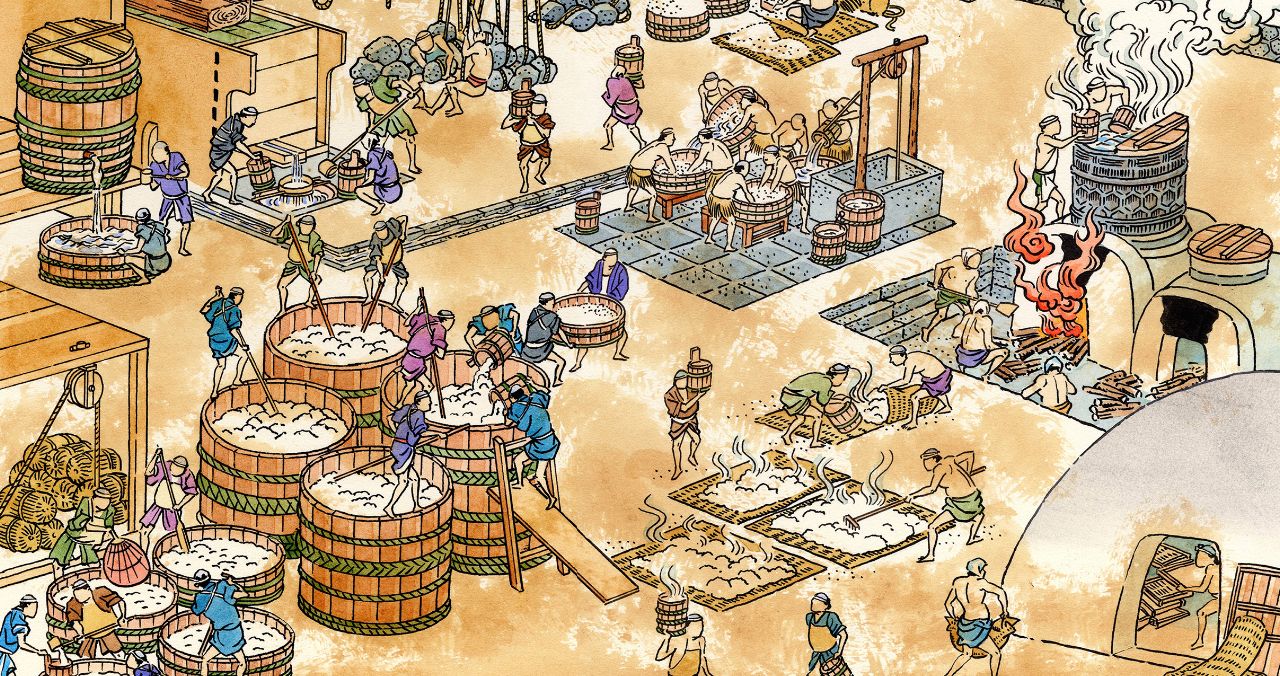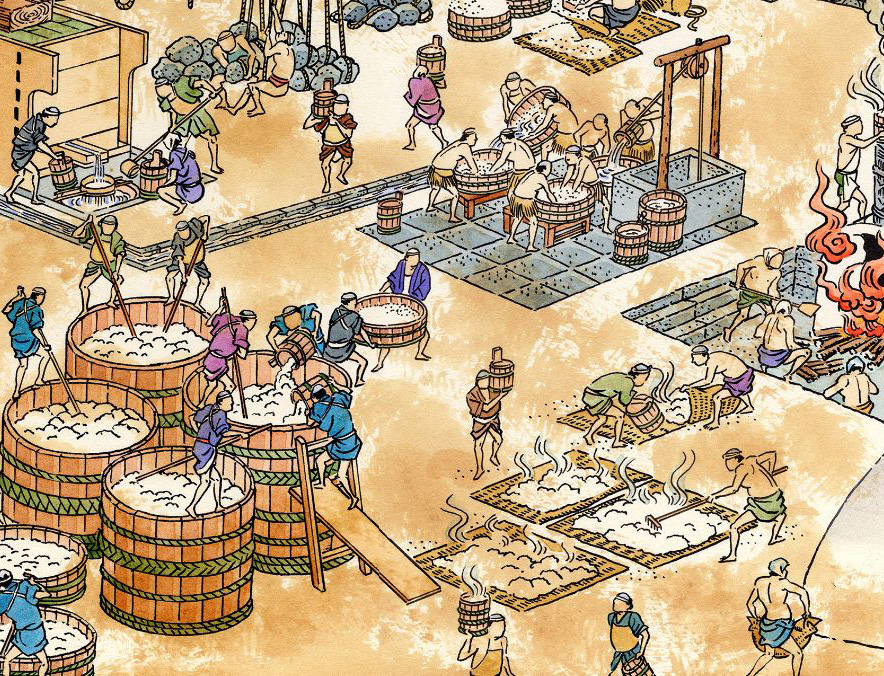Outline of Company History
Before the founding
Three brothers from the Ohta family, who are the owners of Daishichi, moved in the Kan’ei period (1624-1643) in the retinue of Lord Niwa from old Ise province (now Mie prefecture) to the Nihonmatsu domain.(*)Located at the foot of imposing Mt Adatara, this is an area with a rich supply of natural water from sources such as the “Well of Sunshine” (Hikage no Ido), one of Japan’s three most famous wells. Before long, the Ohta family became the feudal domain’s top merchants. Saburobe Yoshishige Ohta during the Meiwa era, and Chozaemon Toyoharu Ohta during the An’ei era, greatly bolstered the family fortunes. Saburouemon, son of Yoshishige, began another family branch, establishing the current Daishichi Sake Brewery.

Traditions of the Ohta family
The following traditions have been transmitted in the Ohta family from parents to children.
“The three Ohta brothers came from Tamaru in Ise. They were of the Seiwa Genji line, and when Lord Niwa entered Nihonmatsu Castle, the three brothers settled here. That was over 300 years ago.”
“The three brothers brought an Amida Buddha triad with them, a family heirloom. They separated the three statues and each brother took one statue home for the protection of his family. Our Amida is the Buddha on the right.”
The children would every morning sit down in front of the Buddha together with their parents to chant the Name of Amida Buddha and recite the sutras. The family always spent some time before breakfast together in front of the Buddha.
These traditions suggest that at least one of the three Amida Buddha statues handed down in the family for over 370 years, since the Niwa family gained power in 1643, still exists. There is also a picture scroll of the journey from Ise to Nihonmatsu.
The history
of Daishichi Sake Brewery
In 1752 (Horeki 2), Saburouemon Ohta became independent and established the current Daishichi Sake Brewery. From that time, until the present 10th generation, Daishichi has always insisted on a strictly orthodox brewing tradition: the kimoto method. Daishichi’s rich, mellow sakes are all outstanding examples of kimoto sake. At the time of founding, the sake was called “Oyama.” The 8th generation head, who in modern times revived the company, changed the brand name to “Daishichi,” incorporating part of the name “Shichiemon,” which is assumed by each head of the family in turn. In his time, Daishichi was designated as the official sake for the formal enthronement of the Showa Emperor in 1928. In 1938, Daishichi was named Grand Champion in the prestigious Japan Sake Awards. Daishichi’s fame spread across Japan.
In the early years of the 20th c. the simpler brewing methods of yamahai and sokujomoto were developed by the National Research Institute of Brewing and soon spread all over the country. The 8th Shichiemon was one of the first to experiment with sokujomoto, but came to the conclusion that only the kimoto method resulted in sake that fulfilled his ideals. At a time that breweries in the whole country one after another gave up the kimoto method, he continued to defend the isolated stronghold of kimoto. Despite the recent boom in light and dry sake, Daishichi has continued to pursue technical improvements to take maximum advantage of kimoto’s powerful qualities. Daishichi became the first brewery in the history of the Japan Sake Awards to win the Gold Medal with a junmai sake made with the traditional kimoto method, firmly establishing its position as leader in kimoto brewing.
On the one hand, Daishichi has introduced such innovations as the super-flat rice polishing method, developed in-house, as well as Japan’s first anoxic bottling system. On the other hand Daishichi has also made efforts to deepen the tradition, for example by newly casting Japanese iron cauldrons and constructing a dedicated facility for brewing in wooden vats. Daishichi has also revived the heritage of various cultural traditions connected with sake making. In 2006 the head of rice polishing, Yoshio Ogata, received the award of “Contemporary Master Craftsman” from the Japanese government, and in 2016 the same honor was awarded to our master brewer, Takanobu Sato. Daishichi is the only sake brewery that has produced Contemporary Master Craftsmen in both rice polishing and sake brewing.
Daishichi seeks universal values in sake brewing and we therefore at an early time shifted our attention to the world outside Japan. At present Daishichi exports to more than 20 countries in the Americas, Europe and Asia. Daishichi is held in very high esteem at the world stage: we have for example provided the sake for the toast at the G8 Toyako Summit and for a gala dinner of European royalty, and are being served in some of the most exclusive restaurants abroad. Daishichi continues to win awards, such as the Governor’s Award at the “First Fukushima Industrial Awards ” (2016) and the Prize of the Minister of Economic Affairs at the “Seventh Monozukuri Japan Awards” (2018). In this way, Daishichi goes on making sake history.
Past Family Heads

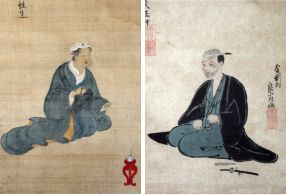
aged 56
Read More
In 1752 (Horeki 2), at the age of 32, Saburouemon, the son of Saburobe Yoshishige Ohta, set up his own independent branch family, which was made possible by the fact that the main family was doing very well. That was on the site where the brewery still stands. The brand name of the sake was “Oyama.”
His portrait shows him in black haori-jacket and gray kimono, an image of frugality. On his side we see a short sword and a fan, which demonstrates he was allowed to wear a sword. In the sharp look of his eyes and deliberate intense expression on his face we can perceive the strong-willed spirit of the founder. Characteristic is the black Buddhist rosary he is holding, showing that he was a very religious person. At the top of this portrait the following eulogy has been inscribed by the 19th abbot of Zenshoji temple, “Praise on the portrait of lay Buddhist Nen’yo Sogo” (the Buddhist name of Saburouemon):
居士旦暮信佛願
As Buddhist, he believed from morning to evening in the Vow of Amida,
馳情送想慕安養
Fervently, he longed for the Pure Land in the West.
坐臥至誠勵稱名
Waking and sleeping, he focused on Nirvana and intoned Amida’s Name,
心鏡元明不受埃
The mirror of his heart was originally clear and free from stains.
闍毘爐中得舎利
At his cremation, sacred relics were found in the ashes,
勿疑棲神遊金池
Without a doubt, he went to Heaven and resides at Golden Pond.
祇畫眞影遺後世
We have depicted his true countenance for future generations,
季孫稽首如在世
His children and grandchildren bow for him as if he were still alive.

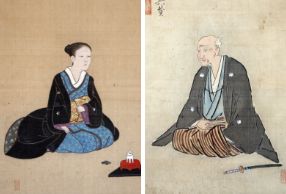
aged 71
Read More
Ihee was five years old when Saburouemon set up the independent branch family. At the death of his father, when he was 29, he became head of the family. Ihee used the sobriquet “Sogi.” He enjoyed the longest life among all Ohta family heads of pre-modern times.
In his portrait, he is wearing a formal haori with a five and three paulownia pattern, and has been pictured with his short sword. This portrait also contains a short eulogy.
嗜 酒 不 乱
In his love of sake, he kept measure,
交 人 克 親
In his contacts with others, he was always close.
三 寶 帰 敬
He sought refuge in the Three Treasures of Buddhism,
持 名 終 全
Reciting the Name, he died focused on Amida.

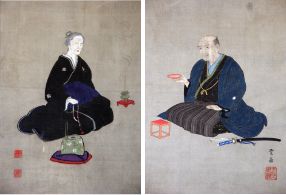
aged 60
Read More
From the 3rd generation on, we find the name Shichiemon, which after that is taken by all family heads. This name may have originated in the Tamaru samurai clan with which the Ohta family had close ties. His portrait depicts the 3rd Generation with a red lacquered sake cup in his hand and a smile on his face, showing that in contrast to the strict spirituality of the founder, he had an easygoing and playful mind. In his dress, too, we find an unconventional sense, which seems to have been typical of the 3rd Generation. He had no sons, so the husband of his eldest daughter was adopted into the family.

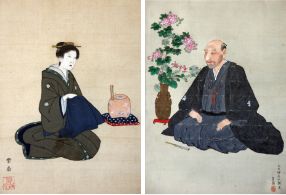
aged 67
Read More
The 4th Generation was the son of Giuemon Endo from Hinodeyama in the Asaka district. Under his direction, the family business prospered and he greatly enhanced its assets. He was publicly praised by the leaders of the town, and was himself active in public office as well. He entertained friendly relations with the castle lord and the samurai of Nihonmatsu.
The following episode has come down about him. Takeda, where the Daishichi brewery stands, has in the past two times been destroyed by fire. The great fire of 1860 was a disaster in which 658 houses were devastated. At that time, the 4th Generation had promised a group of samurai from Nihonmatsu to go together to Tsuchiyu Onsen for a hot spring cure. His family told him he did not have to go at such a dangerous time, but he answered that a promise made to samurai always had to be kept and calmly set out on the trip. But before he had heard details about the great fire of Nihonmatsu, the 4th Generation had on the way to Tsuchiyu bought a large supply of wood. Before he returned home, this huge supply arrived at the burned out premises of Daishichi, so that rebuilding could be started sooner than elsewhere.
The 4th Generation also received a large quince tree from the garden of the villa of the 9th Niwa lord, Lord Nagatomi. This tree had been split in two by lightning and it was a popular belief that a tree once hit by lightning would not be hit a second time. This quince tree was planted in the yard of the brewery, where it still grows today. The tree also led to the family motto of the Ohtas “Lend, do not borrow” (“soto ni kashi, uchi ni karin” - although written differently, “karin,” “not to borrow,” sounds the same as “karin,” “quince tree”).
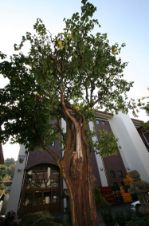

(died before he could take over the name Shichiemon)
1837-1871
aged 35
Read More
In the first year of the Meiji period (1868), Nihonmatsu became one of the battlefields of the Boshin Civil War between the shogunate – supported by Nihonmatsu – and the pro-imperial forces. Before the war reached the town, most citizens had fled to Yonezawa in Yamagata, which was an ally of Nihonmatsu. In the castle town, the tragedy of the Nihonmatsu Youth Corps, which had been formed of teenage boys, was played out: twenty of them died trying to defend the castle. After the castle fell, the town was hit by plundering soldiers, which also left scars on the Ohta family property.
Of only one of the Ohta generations, Choji, there exists no portrait. The 5th Generation died earlier than his father and he therefore never assumed the position of head. It is not certain whether the war was the cause of his early death, but it is easy to imagine that his death was hastened by worries whether he would be able to continue the family business that lay in ruins after the lost war.

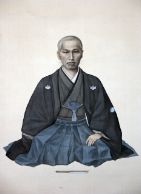
aged 56
Read More
Only a few years after both his parents had died young, the 6th Generation assumed the position of family head at the age of only 19. As his grandfather had also died, he had nobody to help him. Circumstances forced him to take a stand alone.
The young family head had to overcome many hardships, but one special circumstance inspired him to devote his life to sake brewing. The dealer from whom he bought the rice, asked him to pay in cash instead of buying on credit. This meant the brewery had lost trust. However, his wife Haru, who came from a well-known family in Motomiya, the Shigihara family, without hesitation sold her valuable bridal treasures in order to get the money for buying the rice. The 6th Generation was so impressed by his wife’s attitude that he applied himself more diligently than ever to the sake-making business. As a result, he was able to win back trust by exercising sound management until his final years.
Later, the 6th Generation served for several terms as a member of the town assembly of Nihonmatsu, but he also kept devoting himself to the management of the brewery until his final years. In a local history the following has been recorded: “From the time of the 6th Shichiemon until the time of the 7th Shichiemon, the quality of Daishichi’s sake improved significantly and its brand became widely known. Production also increased and the company’s assets grew year by year, so that the family was counted among the handful of wealthy families in Takeda.”

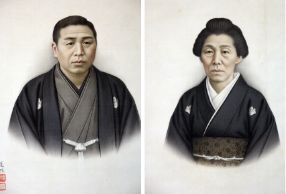
aged 49
Read More
The 7th Generation was adopted into the family as son-in-law. He came originally from the Okabe sake brewing family in Otsuki village in the Asaka district. He had graduated from teacher’s college and his main interest lay in the education and training of young people. As candidate for an officer’s position he was several times called up for military service, and there is still a photo left of him as military officer during the First World War.
When the 6th Generation, who had continued leading the sake business until his final years, died, the 7th Generation became his successor, but he had little experience in sake brewing. On top of that, only three years after becoming head, in 1914-1915, the whole nation was affected by the problem of spoiled sake due to the hiochi bacteria and the 7th Generation died young from a sudden illness due to frustration that he was helpless in the face of this disaster.

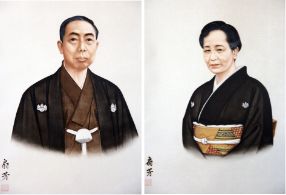
aged 93
Read More
Because of the sudden death of his father, the 8th Generation left Asaka Middle School before graduating and became family head at the tender age of 16. After that, he strove to deepen his knowledge of sake making by visiting famous breweries in Akita prefecture and in the Nada district of Hyogo prefecture. In 1927, Daishichi obtained first prize at the Fukushima Sake Awards. The year after that, Daishichi had the honor to be selected as sake for the enthronement of the Showa Emperor.
In 1938, Daishichi finally won the highest prize at the 16th Japan Sake Awards and so became famous in the whole of Japan.
In the beginning of the 20th century, the kimoto method was replaced by simpler brewing techniques as yamahai and sokujomoto, which spread quickly as they were propagated by the government. When the 8th Generation had just become family head, he tried out the sokujomoto method, but came to the conclusion that in this way he could not brew the sake he wanted. So to be true to his own ideals, he continued using the kimoto method, which later became typical for Daishichi.
The brand name “Daishichi” was also devised by the 8th Generation. The name “Oyama,” dating back to the Edo period, was in use by several other sake breweries as well. Instead, the 8th Shichiemon opted for a name related to the founders, and by taking the “shichi” from “Shichiemon” he decided on the name “Daishichi.” From 1935 he started setting up advertising boards along the railway line with the still famous slogan “Sake is Daishichi.” From an early time on he established the brand and possessed an enterprising mind.
From his youth, the 8th Generation suffered from tuberculosis and at one time he directed the sake brewing from his sick bed with the assistance of his wife Kuni. Because of that experience, he took good care of his health, and finally lived the longest of all the Ohtas. In the years of his prime, he served as member of the town assembly and also as the first chairman of the Nihonmatsu Rotary Club. His prestige was very high. Until his demise at a very advanced age, he dedicated himself adamantly to sake making.

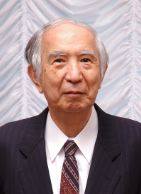
aged 95
Read More
As the 8th Generation was for a long time company president, the 9th Generation assisted him in practical management as vice-president before himself becoming president in 1982. Observing the high-class jizake boom and segmentation of the market in those years, he successfully started selling “Daishichi Kimoto.”
During the jizake boom of light and dry ginjo sakes, the 9th Generation emphasized the kimoto method and the own character of Daishichi. Thanks to his efforts to improve the quality of kimoto sake and implement technological developments, Daishichi came to be regarded as the most typical kimoto brand in the whole of Japan. His tasting ability was exceptional – even to the level that he could say “my tongue is my yardstick.” He contributed to the stable quality of Daishichi and enhanced the trust in our products.
Disliking showiness, the 9th Generation has a cautious and steady character, and has enlarged the scope of the company through sound management without borrowing. He very much likes to keep animals and cultivate flowers, and has a gentle character. He has also served as chief director of the Nihonmatsu Sake Brewers Association.

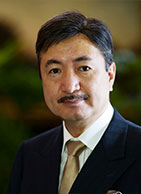
Read More
The 10th Generation who is now president, studied at Fukushima High School and the law department of Tokyo University. After a short training of sake brewery management at the National Research Institute of Brewing, he entered the Daishichi Sake Brewery. In 1997, at the age of 37, he became president. He has served as 40th Chairman of the Alcoholic Beverages Section of the Japan Junior Chamber (1999); Nihonmatsu Section Head of the Fukushima Sake Brewers Association; Chairman of the Nihonmatsu Products Association; and as Chairman of the Adachi Duty Association.
The 10th Generation has devoted his energies to the greater sophistication of the kimoto method and its introduction to the world. He has led such technological innovations as the superflat rice polishing technique and the anoxic bottling system. Besides that, he has also deepened the tradition by reviving brewing in wooden vats and the casting of new iron cauldrons. In 2002, at the occasion of the 250th anniversary of the company, he had a new brewery built as a “temple of handcrafted sake” and also published a history of the company based on detailed research.
The development of top class sake by the orthodox kimoto method, with the eyes fixed on world markets, has earned high praise both in Japan and abroad. Daishichi is exported to more than 20 countries in the Americas, Europe and Asia. In Japan itself, Daishichi has brought about a reevaluation of kimoto sake.
The ambitious management of the 10th Generation president has been rewarded with the following prizes: the First Prize at the “Third Family Business Awards,” the First place / Governor’s Award of the “First Fukushima Industrial Awards,” and the Prize of the Minister of Economic Affairs of the “Seventh Monozukuri Japan Awards.”
Past Master Brewers (toji)
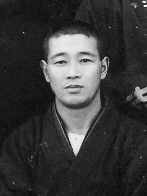
Yosaburo Sato (before the war)(Nanbu toji)
Mr Sato brewed sake with a prayer to the gods and Buddhas in his heart. In 1938 Daishichi obtained the highest prize at the Japan Sake Awards and Daishichi’s fame spread around the country.
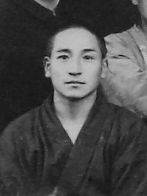
Tomiji Ito (during and after the war)(Nanbu toji)
Mr Ito brewed Daishichi’s sake during the difficult war years with their controlled economy.
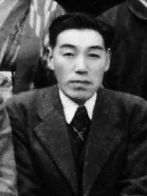
Chokichi Ichinokura (time of rebuilding after the war)(Nanbu toji)
Despite the supply shortage in the immediate postwar years, Mr Ichinokura did not compromise on quality and won the gold medal at the Japan Sake Awards.
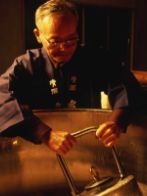
Katsuji Ito (1956)(Nanbu toji)
At the time of high economic growth when mass production spread and traditional methods were discarded, Mr Ito defended the isolated stronghold of the kimoto method. As leader of the kimoto method, in 1992 he was awarded the Brewing Technician Award of the Brewing Society of Japan as well as the Excellent Technician Award of Fukushima Prefecture (“Fukushima Master Craftsman”).
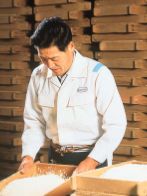
Masakichi Kindaichi (1989)(Nanbu toji)
Mr Kindaichi early on worked as kashira (deputy toji) under master brewer Ito and continued the tradition of the kimoto method at Daishichi. He supervised the brewing of many sakes which became famous and popular. He was also an excellent singer of brewing songs.
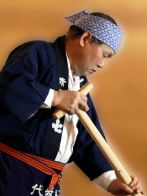
Takanobu Sato (1997)(Nanbu toji)
Mr Sato also started as kashira (deputy toji) before becoming himself master brewer. He has improved the brewing process by his original ideas and aspired to a higher level of quality by making good use of Daishichi’s research laboratory. He is still going strong today. At the Japan Sake Awards he twice won a historical first prize with a junmai sake made by the kimoto method, truly a monumental achievement. Brewing Technician Award of the Brewing Society of Japan, Excellent Technician Award of Fukushima Prefecture (“Fukushima Master Craftsman”), “Contemporary Master Craftsman” Award of the Ministry of Health, Labor and Welfare, Yellow Ribbon Medal of Honor.
Polishing head
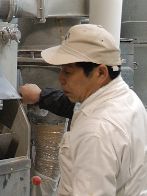
Polishing head・Yoshio Ogata (1977)
Mr Ogata implemented the flat polishing theory (proposed by Saito Tomio) in practice. In 1995 he developed Daishichi’s original superflat rice polishing technique. Award of the Director-General of the Science and Technology Agency, Excellent Technician Award of Fukushima Prefecture, Brewing Technician Award of the Brewing Society of Japan, “Contemporary Master Craftsman” Award of the Ministry of Health, Labor and Welfare. These awards were for the first time in history awarded for rice polishing.




